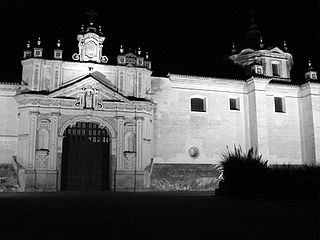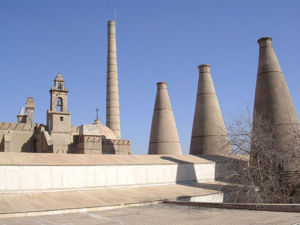
Monastery of Santa Maria de las Cuevas
Encyclopedia

Seville
Seville is the artistic, historic, cultural, and financial capital of southern Spain. It is the capital of the autonomous community of Andalusia and of the province of Seville. It is situated on the plain of the River Guadalquivir, with an average elevation of above sea level...
, southern Spain
Spain
Spain , officially the Kingdom of Spain languages]] under the European Charter for Regional or Minority Languages. In each of these, Spain's official name is as follows:;;;;;;), is a country and member state of the European Union located in southwestern Europe on the Iberian Peninsula...
.
History
Legend holds that the area, in MoorishMoors
The description Moors has referred to several historic and modern populations of the Maghreb region who are predominately of Berber and Arab descent. They came to conquer and rule the Iberian Peninsula for nearly 800 years. At that time they were Muslim, although earlier the people had followed...
times, was honeycombed with caves made by potters for ovens and to obtain clay, and that after the capture of the city by Christians in the thirteenth century, an image of the virgin was revealed inside one of the caves, where supposedly it had been hidden. It prompted the construction of a chapel of Santa María de las Cuevas to house the venerated icon. In the 15th century, the archbishop of Seville, aided by the noble family of Medina, helped found a Franciscan
Franciscan
Most Franciscans are members of Roman Catholic religious orders founded by Saint Francis of Assisi. Besides Roman Catholic communities, there are also Old Catholic, Anglican, Lutheran, ecumenical and Non-denominational Franciscan communities....
monastery at the site. Later constructions were patronized by don Perafán de Ribera (who built the Casa de Pilatos
Casa de Pilatos
La Casa de Pilatos is an Andalusian palace in Seville, Spain, which serves as the permanent residence of the Dukes of Medinaceli. The building is a mixture of Renaissance Italian and Mudéjar Spanish styles...
).
In the 15th century, monks of the cloistered order of Saint Bruno were housed in the monastery. During the Napoleonic invasion, the monastery was sacked and used as barracks. After returning in 1812, the monastery was finally vacated with the general closure of monasteries in 1835-36 (Desamortización de Mendizábal).
Ceramic tile factory

National Monument and museum
In 1964, it was declared a national monument, and now is owned by the government of Andalusia. Restorations were made for the Seville Expo '92Seville Expo '92
The Universal Exposition of Seville took place from Monday, April 20 to Monday, October 12, 1992 on La Isla de La Cartuja , Seville, Spain. The theme for the Expo was "The Age of Discovery" and over 100 countries were represented...
. In 1997, it became the site of a museum of contemporary and ceramic art.

